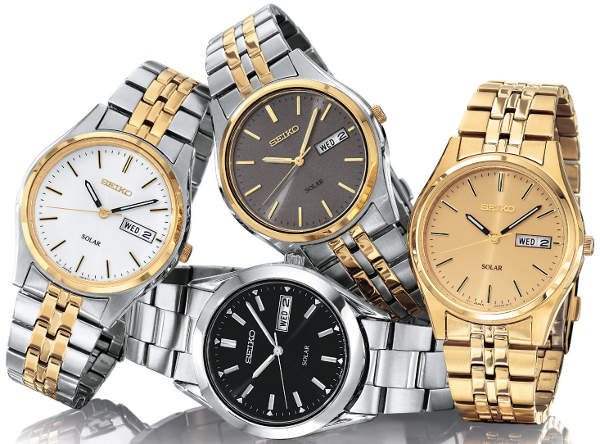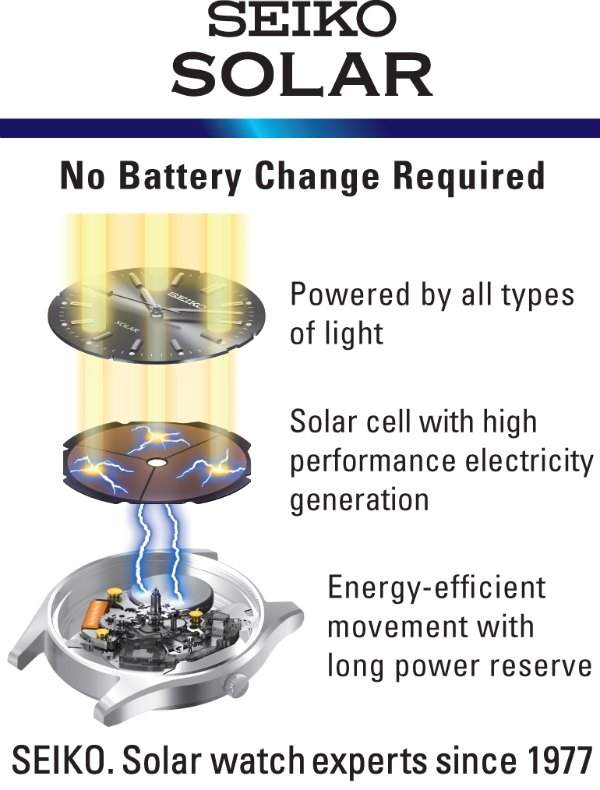 See in the image here in their most basic form, watches with Seiko Solar movements have been around since 1977. But now I think Seiko will start focusing on having Seiko Solar watches enter more of the world market (especially in higher-end forms). For most of the world, the predominant light-powered watch is the Citizen Eco-Drive. Citizen was clever about pushing their light powered watches as being more user-friendly than basic quartz watches.
See in the image here in their most basic form, watches with Seiko Solar movements have been around since 1977. But now I think Seiko will start focusing on having Seiko Solar watches enter more of the world market (especially in higher-end forms). For most of the world, the predominant light-powered watch is the Citizen Eco-Drive. Citizen was clever about pushing their light powered watches as being more user-friendly than basic quartz watches.
One of the main drawbacks of quartz watches is the need to change the batteries from time to time. Movements such as the Seiko Solar and Citizen Eco-Dive have batteries in the movements that are charged by photovoltaic cells in the watch. The lifespan of these movements (assuming they don’t break or malfunction) should be close to one’s lifespan. This is due to the tiny amount of power the movements consume, and the fact that on a full charge the watches can last months without light.
I want to make it clear that these watches derive power from more than just sun light. The Seiko “Solar” name can be a bit confusing, but the movements can generate power from all types of light. Of course, the brighter the light, the faster the batteries will change. Sun light will yield the best results.
For most people, light powered quartz movements are going to be exactly the same as ones with replaceable batteries, in terms of living with them. That is unless you live in the dark most of the time. Recent developments from Seiko has produced dials that don’t even look like traditional ones on light powered watches. Those familiar with Citizen Eco-Drive watches will be familiar with dials designed to cleverly hide the fact that they are semi-transparent. As you can see above, these new Seiko Solar watches – even at bargain prices have dials that don’t look like those we are used to on light-powered watches.
The dial is where light is meant to enter as the photovoltaic cells are located under the dial. Seiko has developed dials that seem totally opaque to the human eye. This advancement could prove very important in Seiko’s plans to start replacing many of their existing quartz watch movements with Seiko Solar watch movements.

Above you’ll find a a collection of dressy style Seiko Solar watches that are currently available in the US. The watches are a bit small at 37mm wide, but were probably created for the Asian market first. They are all in steel cases, some with gold tones applied and are water resistant to 30 meters. Movements have the time and a day/date complication. They are part of the “SNEXXX” range which are all model references numbers starting with “SNE” followed by three digits. My favorite of the pictures pieces is ref. SNE039. Prices for most Seiko Solar watches are between about $150 – $200.
The future of Seiko Solar is much more exciting. Like I said, Seiko seems to have plans to put Seiko Solar movements in to many other watches, such as more sporty or dive watches. Often these watches has Seiko Kinetic (or other special quartz movements), but Seiko will offer a range of them with the Seiko Solar movements as well. I saw image of a few of these from Japan, and they look cool.
Seiko of course has a dilemma having so many movements available to them. The risk is having the consumer be quite confused. Personally I am not clear as to what is a clear winner between Seiko Solar or Seiko Kinetic watch movements in terms of practicality and lifespan. Seiko Solar watches for the time being are often less expensive that Seiko Kinetic watches (which makes sense), but I have a feeling we are going to be seeing more interesting Seiko Solar watches coming soon.
See Seiko Solar watches available on Amazon here.